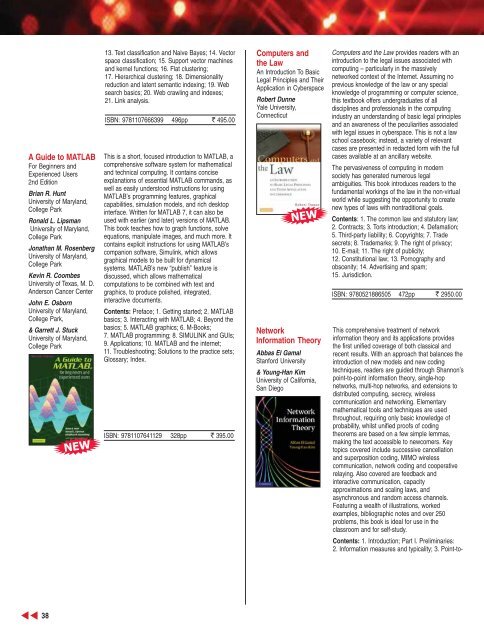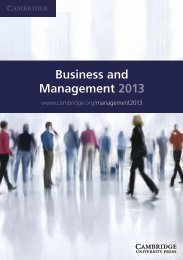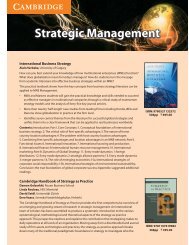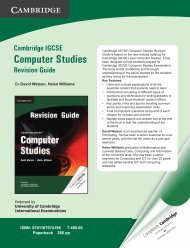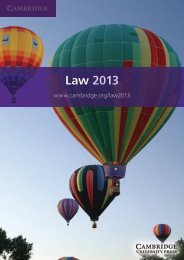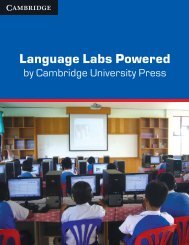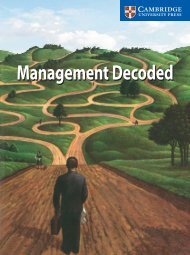ENGINEERING - Cambridge University Press India
ENGINEERING - Cambridge University Press India
ENGINEERING - Cambridge University Press India
You also want an ePaper? Increase the reach of your titles
YUMPU automatically turns print PDFs into web optimized ePapers that Google loves.
A Guide to MATLAB<br />
For Beginners and<br />
Experienced Users<br />
2nd Edition<br />
Brian R. Hunt<br />
<strong>University</strong> of Maryland,<br />
College Park<br />
Ronald L. Lipsman<br />
<strong>University</strong> of Maryland,<br />
College Park<br />
Jonathan M. Rosenberg<br />
<strong>University</strong> of Maryland,<br />
College Park<br />
Kevin R. Coombes<br />
<strong>University</strong> of Texas, M. D.<br />
Anderson Cancer Center<br />
John E. Osborn<br />
<strong>University</strong> of Maryland,<br />
College Park,<br />
& Garrett J. Stuck<br />
<strong>University</strong> of Maryland,<br />
College Park<br />
NEW<br />
13. Text classification and Naive Bayes; 14. Vector<br />
space classification; 15. Support vector machines<br />
and kernel functions; 16. Flat clustering;<br />
17. Hierarchical clustering; 18. Dimensionality<br />
reduction and latent semantic indexing; 19. Web<br />
search basics; 20. Web crawling and indexes;<br />
21. Link analysis.<br />
ISBN: 9781107666399 496pp ` 495.00<br />
This is a short, focused introduction to MATLAB, a<br />
comprehensive software system for mathematical<br />
and technical computing. It contains concise<br />
explanations of essential MATLAB commands, as<br />
well as easily understood instructions for using<br />
MATLAB’s programming features, graphical<br />
capabilities, simulation models, and rich desktop<br />
interface. Written for MATLAB 7, it can also be<br />
used with earlier (and later) versions of MATLAB.<br />
This book teaches how to graph functions, solve<br />
equations, manipulate images, and much more. It<br />
contains explicit instructions for using MATLAB’s<br />
companion software, Simulink, which allows<br />
graphical models to be built for dynamical<br />
systems. MATLAB’s new “publish” feature is<br />
discussed, which allows mathematical<br />
computations to be combined with text and<br />
graphics, to produce polished, integrated,<br />
interactive documents.<br />
Contents: Preface; 1. Getting started; 2. MATLAB<br />
basics; 3. Interacting with MATLAB; 4. Beyond the<br />
basics; 5. MATLAB graphics; 6. M-Books;<br />
7. MATLAB programming; 8. SIMULINK and GUIs;<br />
9. Applications; 10. MATLAB and the internet;<br />
11. Troubleshooting; Solutions to the practice sets;<br />
Glossary; Index.<br />
ISBN: 9781107641129 328pp ` 395.00<br />
Computers and<br />
the Law<br />
An Introduction To Basic<br />
Legal Principles and Their<br />
Application in Cyberspace<br />
Robert Dunne<br />
Yale <strong>University</strong>,<br />
Connecticut<br />
NEW<br />
Network<br />
Information Theory<br />
Abbas El Gamal<br />
Stanford <strong>University</strong><br />
& Young-Han Kim<br />
<strong>University</strong> of California,<br />
San Diego<br />
Computers and the Law provides readers with an<br />
introduction to the legal issues associated with<br />
computing – particularly in the massively<br />
networked context of the Internet. Assuming no<br />
previous knowledge of the law or any special<br />
knowledge of programming or computer science,<br />
this textbook offers undergraduates of all<br />
disciplines and professionals in the computing<br />
industry an understanding of basic legal principles<br />
and an awareness of the peculiarities associated<br />
with legal issues in cyberspace. This is not a law<br />
school casebook; instead, a variety of relevant<br />
cases are presented in redacted form with the full<br />
cases available at an ancillary website.<br />
The pervasiveness of computing in modern<br />
society has generated numerous legal<br />
ambiguities. This book introduces readers to the<br />
fundamental workings of the law in the non-virtual<br />
world while suggesting the opportunity to create<br />
new types of laws with nontraditional goals.<br />
Contents: 1. The common law and statutory law;<br />
2. Contracts; 3. Torts introduction; 4. Defamation;<br />
5. Third-party liability; 6. Copyrights; 7. Trade<br />
secrets; 8. Trademarks; 9. The right of privacy;<br />
10. E-mail; 11. The right of publicity;<br />
12. Constitutional law; 13. Pornography and<br />
obscenity; 14. Advertising and spam;<br />
15. Jurisdiction.<br />
ISBN: 9780521886505 472pp ` 2950.00<br />
This comprehensive treatment of network<br />
information theory and its applications provides<br />
the first unified coverage of both classical and<br />
recent results. With an approach that balances the<br />
introduction of new models and new coding<br />
techniques, readers are guided through Shannon’s<br />
point-to-point information theory, single-hop<br />
networks, multi-hop networks, and extensions to<br />
distributed computing, secrecy, wireless<br />
communication and networking. Elementary<br />
mathematical tools and techniques are used<br />
throughout, requiring only basic knowledge of<br />
probability, whilst unified proofs of coding<br />
theorems are based on a few simple lemmas,<br />
making the text accessible to newcomers. Key<br />
topics covered include successive cancellation<br />
and superposition coding, MIMO wireless<br />
communication, network coding and cooperative<br />
relaying. Also covered are feedback and<br />
interactive communication, capacity<br />
approximations and scaling laws, and<br />
asynchronous and random access channels.<br />
Featuring a wealth of illustrations, worked<br />
examples, bibliographic notes and over 250<br />
problems, this book is ideal for use in the<br />
classroom and for self-study.<br />
Contents: 1. Introduction; Part I. Preliminaries:<br />
2. Information measures and typicality; 3. Point-to-<br />
38


